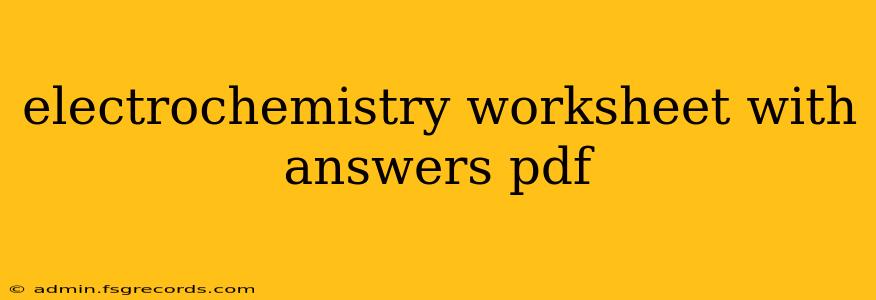Electrochemistry Worksheet: A Comprehensive Guide with Answers
This worksheet provides a thorough exploration of electrochemistry, covering fundamental concepts and challenging applications. It's designed to test your understanding and solidify your knowledge of redox reactions, electrochemical cells, and related calculations. Each problem is accompanied by a detailed solution, allowing you to check your work and identify areas for improvement. This is ideal for high school and undergraduate students studying chemistry.
Section 1: Fundamental Concepts
1. Define electrochemistry.
Answer: Electrochemistry is the branch of chemistry that studies the relationship between electrical energy and chemical reactions. It explores how chemical reactions can produce electricity (galvanic cells) and how electricity can drive chemical reactions (electrolytic cells).
2. Explain the difference between oxidation and reduction.
Answer: Oxidation is the loss of electrons by a species, resulting in an increase in its oxidation state. Reduction is the gain of electrons by a species, resulting in a decrease in its oxidation state. These processes always occur simultaneously – one species is oxidized while another is reduced (redox reaction).
3. What is a redox reaction? Provide an example.
Answer: A redox reaction (reduction-oxidation reaction) is a chemical reaction involving the transfer of electrons between two species. One species undergoes oxidation (electron loss), and another undergoes reduction (electron gain).
Example: The reaction between zinc and copper(II) ions: Zn(s) + Cu²⁺(aq) → Zn²⁺(aq) + Cu(s). Zinc is oxidized (loses electrons), and copper(II) ions are reduced (gain electrons).
4. State the difference between an anode and a cathode.
Answer: In an electrochemical cell:
- Anode: The electrode where oxidation occurs. Electrons flow from the anode.
- Cathode: The electrode where reduction occurs. Electrons flow to the cathode.
5. What is an electrochemical cell?
Answer: An electrochemical cell is a device that converts chemical energy into electrical energy (galvanic cell) or electrical energy into chemical energy (electrolytic cell). It consists of two electrodes immersed in an electrolyte solution, connected by an external circuit.
Section 2: Galvanic Cells (Voltaic Cells)
1. Describe the components of a simple galvanic cell.
Answer: A simple galvanic cell consists of two half-cells: an anode (where oxidation occurs), a cathode (where reduction occurs), an electrolyte solution in each half-cell containing ions that participate in the redox reaction, a salt bridge (or porous membrane) connecting the two half-cells to allow ion flow and maintain electrical neutrality, and an external circuit connecting the electrodes to allow electron flow.
2. Calculate the standard cell potential (E°cell) for the following reaction at 25°C:
Zn(s) | Zn²⁺(aq) || Cu²⁺(aq) | Cu(s)
Given: E°(Zn²⁺/Zn) = -0.76 V; E°(Cu²⁺/Cu) = +0.34 V
Answer: E°cell = E°(cathode) - E°(anode) = E°(Cu²⁺/Cu) - E°(Zn²⁺/Zn) = +0.34 V - (-0.76 V) = +1.10 V
3. What is a salt bridge and what is its function?
Answer: A salt bridge is an ionic conductor (typically a U-shaped tube filled with an inert electrolyte like KNO₃) connecting the two half-cells of a galvanic cell. Its function is to maintain electrical neutrality in both half-cells by allowing the flow of ions to compensate for the charge imbalance created by the electron flow in the external circuit.
Section 3: Electrolytic Cells
1. What is electrolysis?
Answer: Electrolysis is the process of using an electric current to drive a non-spontaneous chemical reaction. It's the opposite of a galvanic cell; electrical energy is used to cause a chemical change.
2. Describe the process of electroplating.
Answer: Electroplating is an electrolytic process where a thin layer of a metal is deposited onto a conductive surface (e.g., coating iron with chromium). The object to be plated acts as the cathode, the plating metal is the anode, and an electrolyte solution containing ions of the plating metal is used.
3. What factors affect the amount of substance deposited during electrolysis?
Answer: The amount of substance deposited during electrolysis depends on:
- Current (I): The higher the current, the more substance deposited.
- Time (t): Longer electrolysis time leads to more substance deposited.
- Molar mass (M): Higher molar mass requires more charge to deposit the same mass.
- Number of electrons transferred (n): The number of electrons involved in the reduction reaction. This is determined by the balanced half-reaction. (Faraday's Law)
Section 4: Calculations (Faraday's Law)
(Include problems requiring application of Faraday's Law - calculate mass deposited, current required, etc. Solutions will require detailed steps and unit conversions.)
(Note: Specific problems and solutions for Section 4 would be included here in a downloadable PDF version of this worksheet. The complexity of the problems can be adjusted based on the target audience.)
This worksheet provides a solid foundation in electrochemistry. Remember to practice applying these concepts to various problems to strengthen your understanding. Further research into specific applications of electrochemistry, such as batteries and fuel cells, will enhance your knowledge even more.

